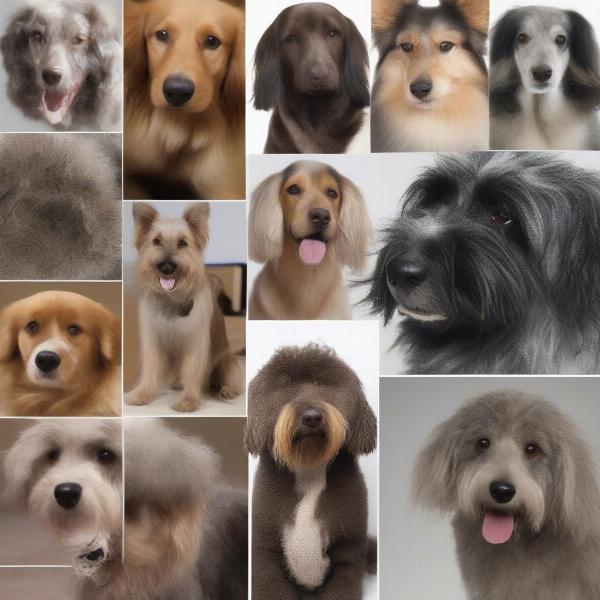Dog fur real – it’s more than just a fluffy covering. It plays a crucial role in your dog’s health and well-being, providing insulation against the elements, protection from the sun, and even contributing to their sense of touch. Whether you’re a seasoned dog owner or just starting your journey with a canine companion, understanding your dog’s fur is essential for providing the best possible care. This article will delve into the fascinating world of dog fur, covering everything from the different types of coats to proper grooming techniques.
Decoding Dog Coat Types
Just like humans have different hair types, dogs boast a diverse range of coat textures, lengths, and colors. Understanding your dog’s specific coat type is crucial for tailoring their grooming routine and ensuring their comfort. Generally, dog coats fall into a few main categories:
- Smooth Coats: These short, sleek coats are relatively low-maintenance, requiring minimal brushing. Examples include breeds like Beagles and Dobermans.
- Double Coats: These coats consist of a dense undercoat for insulation and a longer, coarser outer coat for protection. Breeds like Huskies and Golden Retrievers have double coats that require regular brushing, especially during shedding season.
- Long Coats: As the name suggests, these coats are long and flowing, often requiring daily brushing to prevent mats and tangles. Popular examples include Afghan Hounds and Yorkshire Terriers.
- Wire Coats: These wiry, coarse coats are water-resistant and relatively low-shedding. Breeds like Wire Fox Terriers and Schnauzers typically have wire coats.
- Curly Coats: Tightly curled coats, like those seen on Poodles and Bichon Frises, require regular grooming to prevent matting and skin issues.
Grooming Your Dog’s Fur: Essential Tips
Proper grooming is crucial for maintaining your dog’s coat health and overall hygiene. While the specific grooming needs vary depending on the coat type, some general guidelines apply to all dogs:
- Brushing: Regular brushing helps remove loose fur, prevents mats and tangles, and distributes natural oils, keeping the coat healthy and shiny.
- Bathing: Bathe your dog as needed, using a dog-specific shampoo and conditioner to avoid skin irritation.
- Nail Trimming: Keep your dog’s nails trimmed to prevent discomfort and overgrowth.
- Ear Cleaning: Regularly clean your dog’s ears to prevent infections and wax buildup.
Dog Fur Real: Health Indicators
Your dog’s fur can tell you a lot about their overall health. Changes in coat texture, color, or shedding patterns can be indicators of underlying medical conditions. If you notice any unusual changes in your dog’s fur, it’s essential to consult with a veterinarian.
Is shedding normal for dogs?
Yes, shedding is a natural process for dogs. However, excessive shedding or bald patches can be a sign of health issues.
What can cause changes in my dog’s coat?
Nutritional deficiencies, allergies, parasites, and hormonal imbalances can all affect a dog’s coat.
 Dog Fur Health Indicators
Dog Fur Health Indicators
Conclusion: Ensuring a Healthy, Happy Coat
Dog fur real – it’s a vital part of your canine companion’s well-being. By understanding the different coat types, practicing proper grooming techniques, and paying attention to any changes in your dog’s fur, you can help ensure they maintain a healthy, happy, and beautiful coat for years to come.
FAQs
- How often should I brush my dog? The frequency of brushing depends on the dog’s coat type. Long-haired dogs typically require daily brushing, while short-haired breeds may only need weekly brushing.
- What type of brush is best for my dog? Different coat types require different brushes. Consult with a groomer or veterinarian to determine the best brush for your dog’s specific needs.
- Can I use human shampoo on my dog? No, human shampoo can disrupt the pH balance of a dog’s skin, leading to irritation and dryness. Always use a dog-specific shampoo.
- What should I do if my dog’s fur is matted? If your dog’s fur is severely matted, it’s best to consult a professional groomer. Attempting to remove mats yourself can cause pain and discomfort to your dog.
- How can I reduce shedding in my dog? Regular brushing, a healthy diet, and omega-3 fatty acid supplements can help reduce shedding.
- What are the signs of a healthy dog coat? A healthy dog coat is shiny, soft, and free of mats and tangles.
- When should I consult a veterinarian about my dog’s fur? If you notice any unusual changes in your dog’s coat, such as excessive shedding, bald patches, or skin irritation, consult with a veterinarian.
Related Articles:
About ILM Dog:
ILM Dog is your trusted resource for all things dog-related. We offer expert advice on dog breeds, health and medical care, training, nutrition, grooming, and more. Our mission is to empower dog owners worldwide with the knowledge and resources they need to provide the best possible care for their canine companions. From puppy care to senior dog support, and from finding the right accessories to choosing the perfect dog sitter – ILM Dog is here for you. For any inquiries, please contact us at [email protected] or call us at +44 20-3965-8624. Visit us at ILM Dog for more valuable information.